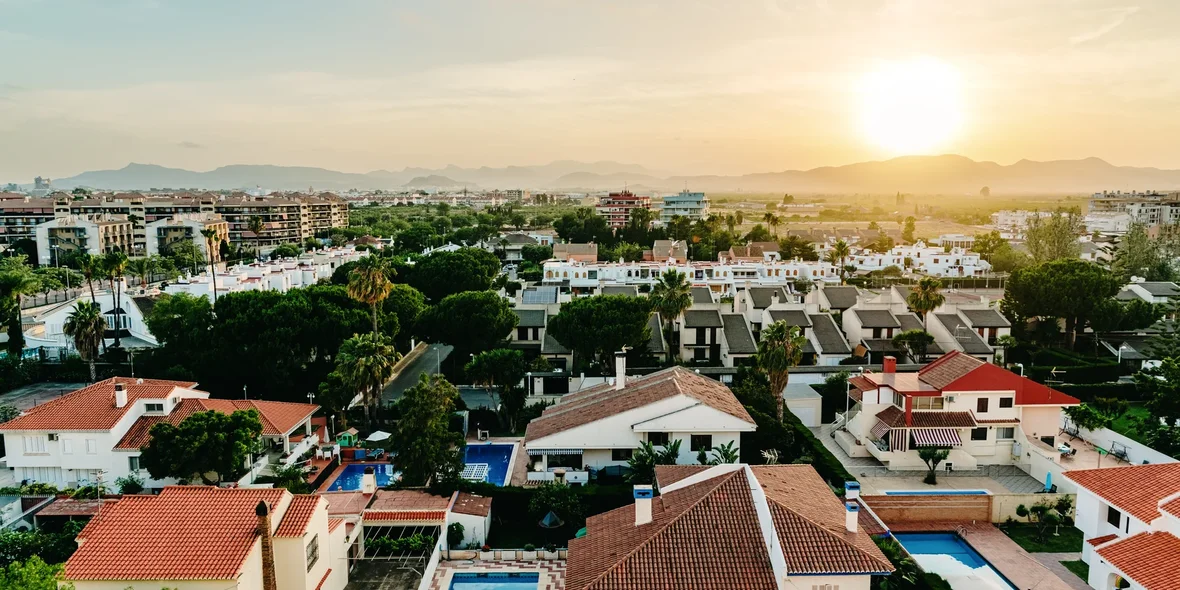
Real Estate Taxes in Spain: A Complete Guide for Buyers, Owners, and Sellers
The Spanish real estate market remains one of the most attractive in Europe. In 2025, according to data from the National Statistics Institute (INE), the volume of residential property transactions increased by 4.2% compared to the previous year, with a notable rise in interest from foreign investors in particular.
However, the Spain real estate tax system can be complex. Our guide covers all property taxes in Spain at the stages of purchase, ownership, and sale, including both specific property taxes and general tax mechanisms.
Taxes When Purchasing Real Estate in Spain
Buying property in Spain comes with substantial tax obligations. For newly built properties purchased directly from a developer, the main tax is the Spanish VAT on property, whereas for resale properties, it is the Spain property transfer tax.
Before completing any transaction, non-residents must obtain an NIE (Número de Identidad de Extranjero). Without it, financial operations within the country, including opening a bank account, are not possible.
IVA (Impuesto sobre el Valor Añadido)
This is the equivalent of VAT on property in Spain, mandatory when purchasing new object (vivienda nueva). It applies to apartments, houses, villas, and other residential units being put into use for the first time. The rates are:
- 10% for residential properties, including apartments, houses, and townhouses intended for personal use.
- 21% for commercial properties (offices, shops) and building plots.
- 4% (reduced rate) for social housing (vivienda protegida, VPO), provided that size and income criteria are met.
The developer is required to include the VAT in the invoice (factura), which is given to the buyer or stated in the property listing. This tax is non-refundable.
Stamp Duty (Impuesto sobre Actos Jurídicos Documentados, AJD)
Known as AJD stamp duty in Spain, this tax is charged when purchasing new property (in addition to VAT) and when formalizing mortgage agreements. AJD applies to notarized deeds that must be registered in the Registro de la Propiedad. The rate varies by region, from 0.5% to 2%:
- Andalusia: 1.2–1.5% (reduced to 0.3% for social housing).
- Catalonia: 1.5–2%.
- Madrid: 0.4–0.75% (one of the lowest in Spain).
Some regions (e.g., Valencia) reduce AJD to 0.1% for young buyers (<35 years) or large families purchasing their main residence. In the Canary Islands, an alternative tax (IGIC) applies instead of VAT, but AJD remains in place.
Property Transfer Tax (Impuesto sobre Transmisiones Patrimoniales, ITP)
The ITP tax Spain applies when purchasing resale property (vivienda de segunda mano) on the secondary market, including transactions between individuals or legal entities not subject to VAT. Rates also vary by region, from 6% to 11%:
- Andalusia: 7% (up to €400,000), 8% (€400,000—700,000), 10% (over €700,000).
- Catalonia: 10% (up to €1,000,000), 11% (over €1,000,000).
- Madrid: 6% (flat rate, among the lowest in Spain).
- Valencia: 8–10% (depending on price and buyer category).
- Canary Islands: 6.5% (IGIC may apply instead of ITP in certain cases).
Residents may be eligible for reduced rates in Madrid — 4% for primary residences priced up to €250,000 and for buyers under 35. In Andalusia, a reduced rate of 3.5% applies to large families or buyers of social housing. Non-residents are not eligible for these benefits.
Taxes on Property Ownership in Spain
Owning real estate in Spain comes with paying annual property-related taxes. While these are generally lower than purchase or sale taxes, they are still important to account for.
Property Tax (Impuesto sobre Bienes Inmuebles, IBI)
A mandatory municipal tax levied on the ownership of property (residential, commercial, and land plots). This IBI property tax Spain applies to all owners, regardless of residency status. The rate is set by each municipality based on the cadastral value (valor catastral) and ranges from 0.4% to 1.3%:
- Urban areas: 0.4–1.1% (e.g., 0.8% in Barcelona, 0.6% in Madrid).
- Rural areas: 0.3–0.9%.
- Commercial property: up to 1.3%.
Failure to pay IBI can result in property seizure. If the cadastral value is overstated, it can be challenged via Catastro (procedure takes 6–12 months).
Local Service Charge (Tasa por Recogida de Basuras)
A municipal fee covering waste collection, street cleaning, and other public services. Ranges from €50 to €300/year, depending on the municipality — approx. €100—140/year in Madrid, and up to €250/year on the Costa del Sol. Non-resident landlords may pass this fee to tenants through the rental agreement.
Rental Income Tax
Income from rentals is subject to the Spain rental income tax (Impuesto sobre la Renta de las Personas Físicas, IRPF) at progressive rates:
- 19% (up to €12,450).
- 24% (€12,450—20,200).
- 30% (€20,200—35,200).
- 37% (€35,200—60,000).
- 45% (€60,000—300,000).
- 47% (over €300,000).
Residents may deduct mortgage interest, insurance, maintenance expenses, etc., from the taxable base. If the property is rented as a primary residence, 50% of net rental income is temporarily tax-exempt.
Rental income for non-residents is taxed under Impuesto sobre la Renta de No Residentes (IRNR) at fixed rates:
- 19% for residents of the EU, Iceland, and Norway.
- 24% for others.
Deemed Income Tax (Imputación de Rentas Inmobiliarias)
Applicable specifically to non-residents owning property for personal use rather than rental. This is a notional tax charged even when no income is generated. The taxable base is calculated as a percentage of the cadastral value:
- 2% — if the cadastral value has not been updated in recent years.
- 1.1% — if it has been updated within the last 10 years.
The Spain Wealth Tax (Impuesto sobre el Patrimonio)
An annual tax on an individual’s net worth. Residents are taxed on worldwide assets; non-residents — only on assets located in Spain. The general exemption threshold (mínimo exento) is €700,000. If total assets are below this, no tax is due. Property tax exemptions in Spain are relevant for primary residence (vivienda habitual) up to €300,000. For properties above this value, only the excess counts toward the taxable base. For non-residents, Spanish property typically does not qualify as a primary residence. After exemptions, the following progressive scale applies:
- €0—167,129 — 0.20%.
- €167,129—334,252 — 0.30%.
- €334,252—668,499 — 0.50%.
- €668,499—1,336,999 — 0.90%.
- €1,336,999—2,673,999 — 1.30%.
- €2,673,999—5,347,998 — 1.70%.
- €5,347,998—10,695,996 — 2.10%.
- Over €10,695,996 — 3.50%.
Taxes When Selling Property in Spain
The main taxes on the sale of real estate in Spain are the capital gains tax (IRPF for residents, IRNR for non-residents) and the municipal land value increase tax (Plusvalía Municipal).
Capital Gains Tax (Impuesto sobre la Renta)
Residents pay capital gains tax in Spain on the profit from the sale of real estate calculated as the difference between the selling price and the purchase price, adjusted for allowable expenses and inflation. The progressive rates are:
- Up to €6000 — 19%.
- €6,000—€50,000 — 21%.
- €50,000—€200,000 — 23%.
- €200,000—€300,000— 27%.
- Over €300,000 — 28%.
Certain rules can help with how to avoid capital gains tax in Spain. Full exemption applies when selling a primary residence (vivienda habitual) registered as the place of residence for at least 3 years. If the profit from the sale of a primary residence is reinvested into the purchase of another primary residence within 2 years, the tax is not applied (full or partial exemption depending on the reinvested amount).
For non-residents, capital gains are taxed under the Impuesto sobre la Renta de No Residentes (IRNR) at a flat 19% rate, with the gain calculated in the same way as for residents.
Special rule for non-resident sellers: the buyer must withhold 3% of the sale price and pay it to the Agencia Tributaria as an advance payment of the IRNR. This amount is offset against the final tax due. If the tax is less than 3%, the seller can claim a refund after filing the tax return.
Municipal Land Value Increase Tax (Plusvalía Municipal)
Often referred to as Plusvalía Municipal Spain, this tax is charged by municipalities on the increase in the cadastral value of the land (valor catastral del suelo) from the time of purchase to the time of sale. If the property (and thus the land) is sold for less than it was purchased for, it is considered a capital loss, and the tax is not levied.
There are two calculation methods, and taxpayers may choose the one resulting in a lower liability. In objective method the taxable base is the cadastral land value multiplied by a coefficient based on ownership duration:
|
Years owned |
Max. coefficient |
|
<1 |
0.14 |
|
1–2 |
0.13 |
|
3–4 |
0.15 |
|
5–9 |
0.17 |
|
10–15 |
0.09 |
|
16–20 |
0.45 |
For example, if property has been owned for 11 years with a cadastral value of €120,000, and the land portion is 50% (€60,000). The base is €60,000 × 0.09 = €5400. If the municipal tax rate is 20%, the payable tax is €5400 × 0.20 = €1080.
The second method is a real one. The taxable base is calculated from the actual increase in the land value. First, determine the total capital gain on the property. The price difference is established using the notarized purchase and sale deeds, excluding transaction-related expenses. Example: a property was purchased for €250,000 and sold for €300,000, the capital gain is €50,000.
Next, determine the proportion of the land in the total cadastral value of the property. This figure is specified in the property’s record in the Spanish Land Registry. Example: if the land share is 50%, the taxable base will be €50,000 × 0.5 = €25,000. Finally, multiply this amount by the municipal tax rate. If the rate is 20%, the tax payable will be €25,000 × 0.20 = €5000.
Regional Property Taxes in Spain
Spain’s tax system is decentralized, and the autonomous communities (Comunidades Autónomas) set their own rates, exemptions, and rules for property-related taxes. Below is an overview of key regional differences.
Taxes on property purchase:
|
Region |
ITP (Resale) |
IVA/IGIC (New) |
AJD |
Selected Benefits / Special Rules |
|
Andalusia |
7% flat |
IVA: 10% (residential), 21% (commercial) |
1.2% |
ITP 3.5% for large families and young buyers (<35 years) |
|
Catalonia |
10–13% |
IVA: 10% (residential), 21% (commercial) |
3.5% |
ITP 5% for young buyers (<32 years) |
|
Madrid |
6% |
IVA: 10% (residential), 21% (commercial) |
0.75% |
ITP 4% for large families |
|
Valencian Community |
10–11% |
IVA: 10% (residential), 21% (commercial) |
1.5% |
ITP 6% for large families and young buyers (<35 years) |
|
Canary Islands |
6.5% general |
IGIC (instead of IVA): 7% |
0.75% |
Additional youth reductions discussed but not yet introduced |
Taxes on property ownership:
|
Region |
IBI |
Wealth Tax |
Waste Collection Fee |
|
Madrid |
0.4–0.6% |
Abolished for residents |
€50–150/year |
|
Andalusia |
0.5–1% |
€700,000 threshold; 0.2–3.45% |
€150–300/year |
|
Catalonia |
0.7–1.1% |
€100–250/year |
|
|
Valencian Community |
0.6–0.9% |
€100–250/year |
|
|
Canary Islands |
0.5–0.8% |
€50–200/year |
Taxes on property sale:
|
Region |
Plusvalía Municipal |
Benefits |
|
Andalusia |
25–30% |
Exemptions for residents over 65 and for low-income individuals |
|
Catalonia |
20–30% |
|
|
Madrid |
15–25% |
|
|
Valencian Community |
20–30% |
|
|
Canary Islands |
15–25% |
Frequently Asked Questions About Taxes in Spain
What taxes are paid when purchasing property in Spain?
When buying property in Spain, you pay VAT (IVA) 10% for primary residential property and 21% for commercial property. In the Canary Islands, VAT is replaced by IGIC at 6.5% for residential properties. For resale property, the Property Transfer Tax (ITP) applies, ranging from 6% in Madrid to 10–11% in Catalonia. There is also a Stamp Duty (AJD) of 0.4–2%, depending on the region.
What are the taxes on owning property in Spain?
Owners pay an annual Property Tax (IBI) of 0.4–1.3% of the cadastral value, with exact rates depending on the region: 0.4–0.6% in Madrid, 0.7–1.1% in Catalonia. If total assets exceed €700,000, Wealth Tax (Impuesto sobre el Patrimonio) is charged at 0.2–3.45%, although it has been abolished for residents of Madrid. Waste collection fees are paid separately and set by local councils, generally ranging from €50 to €300 per year nationwide.
What taxes are due when selling property in Spain?
Sellers pay Capital Gains Tax (Impuesto sobre la Renta). For residents, the progressive rate is 19–28%; for non-residents, it is a flat 19%. For non-resident sellers, the buyer must withhold 3% of the sale price as an advance payment toward this tax. There is also the Municipal Land Value Increase Tax (Plusvalía Municipal), with rates typically between 15% and 30% depending on the municipality. If no profit was made from the sale, this tax is not charged.
Author
I write informative articles about real estate, investments, job opportunities, taxes, etc.























